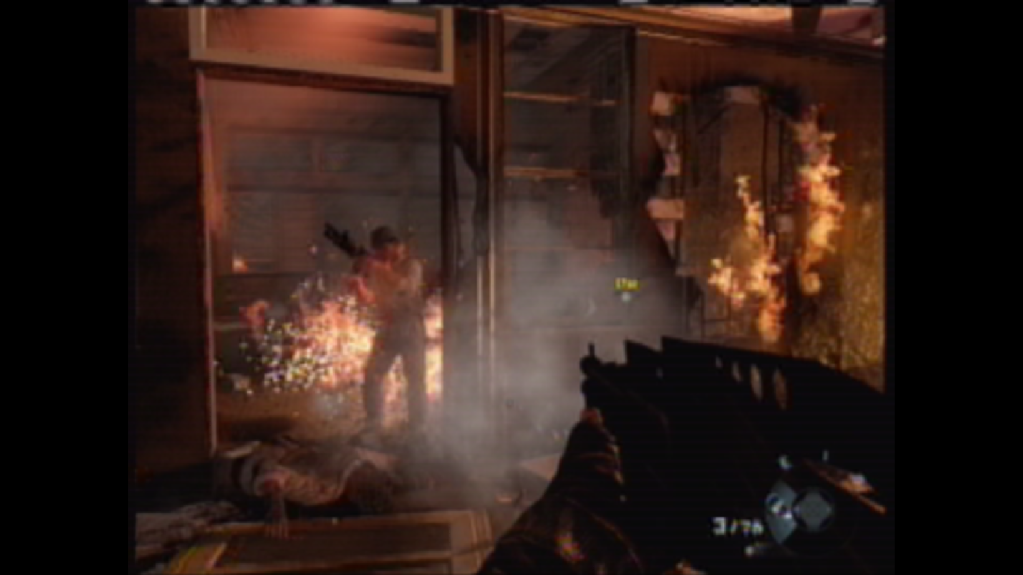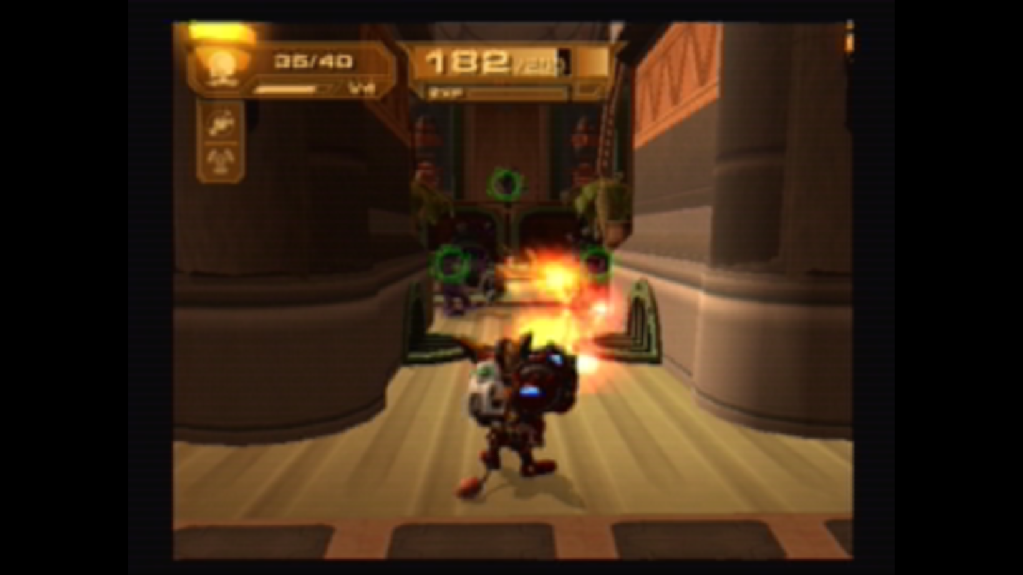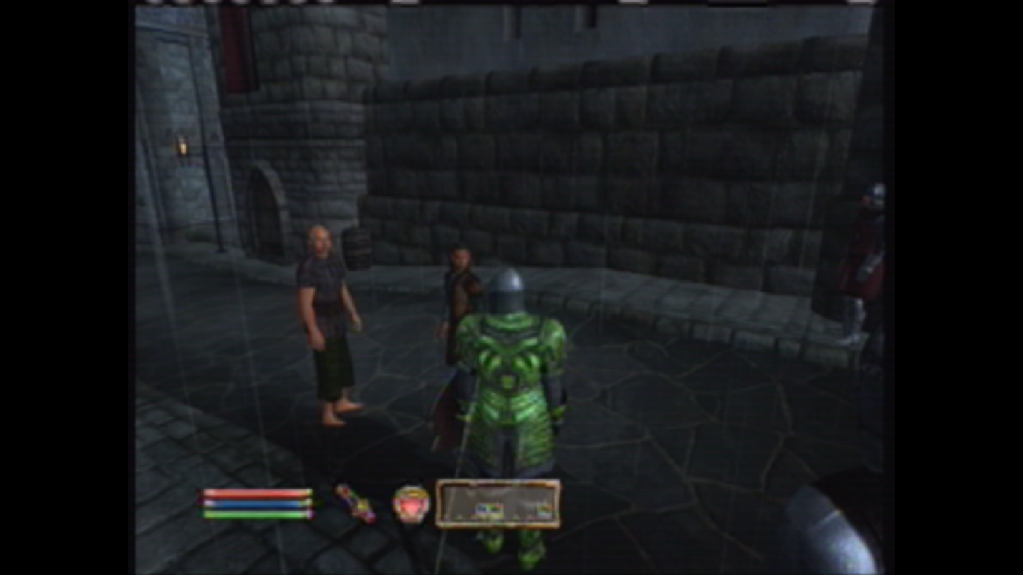Concept
This is the most forgiving of the 3 elements of reviewing games. Every developer has a goal in mind when producing a game, and the concept of the game is the experience which producers intend to convey to the player. Whether that goal is something safe and familiar to the consumers, such as a military-themed FPS or a medieval-themed RPG, or if the game focuses on more abstract, unexplored themes, the object of the game sets its tone from the get-go. Even games that use simple concepts to hook players like Tetris or Lumines have set good goals, because they are so concise.
For example, a genre with which the public is familiar is the First-Person Shooter (FPS.) As long as the game doesn't deviate too much from the core formula of shooting enemies in between checkpoints, the players know what they're getting themselves into at the time of purchase and hopefully enjoy the game every step of the way. FPS games have proven to be an enjoyable experience for many consumers, and have become a staple of the gaming industry as a result.
 |
| Call of Duty is a modern FPS at its purest. |
Contrasting both the bleeding edge of innovation and the security of industry staples, a game whose object is completely inane and suffers for it is the 2007 promotional game, Sneak King. If reviewed alongside contemporary retail games, Sneak King is a flop. The goal of the game is to provide Burger King products to hungry people without getting caught.
Sneak King has a very low ceiling setting above its head, because the goal of the game is short on inspiration. Even if Sneak King featured a revolutionary interactive narrative mechanic and cutting edge graphics and sound, its intentional campiness prevents it from reaching any level of impact or influence.
 |
| Whoppers aren’t the only thing with cheese… |
Let the fact that I had to resort to considering a fast food promotional deal to find a game with a bad videogame concept with which to compare a good concept. The contemporary gaming market is far more often than not inhabited by games with good concepts, and bad concepts are the minority. Even videogames aimed at children can have sound concepts, as long as they are age-appropriate.
Additionally, the goal of the game must be acknowledged when rating its performance under certain criteria. A design choice must be recognized as context appropriate, rather than a flaw. The black-and-white visuals presented by 2010’s LIMBO are bad by conventional standards, but are unique when considering the minimalistic nature of the game. Another sound example is within the Ratchet and Clank franchise, all of which feature simple, jovial storylines and humor. Elaborate storylines a la Metal Gear Solid or weapons and wounds as they appear in the Halo franchise would simply feel out of place in such a feel-good game.
 |
| There are no extra points for headshots on Tyrranhoids. |
The concept of the game is the best way to evaluate it at face value. Whether a game carries the ambitious goals of a triple-A holiday release or those of a simple, monothematic XBLA or PSN release, what the producers have chosen to convey to the player is the first and primary set of criteria from which all other evaluations stem.
Direct Competition
Sadly, the main limiting factor for many games is the saturation of their niche. Games that are products of fads or derivatives of successful titles within the videogame industry itself are the main perpetrators in this case. All too often, a game that is commercially successful and revolves around an unusual concept sees a slew of copycats in its wake.
Gamers saw this effect in play during the early 2000s, as the success of Grand Theft Auto III inspired a myriad of antihero/sandbox-style games that flooded the market for a good five years. Alongside the sandbox fad was the World War II themed FPS, all following the tracks left by Medal of Honor. During the early 1990s, while Mario and Sonic were neck-and-neck in the race for console platformer supremacy, they were followed to the finish line by untold numbers of copycats; everything from movie-licensed cash-ins to start-up franchises saw 2D, side-scrolling entries and interpretations. Most recently, shooting games with an emphasis on online play and leveling systems have been the games to produce; just about every FPS released since 2007's Call of Duty 4: Modern Warfare hit the market has been emulating its formula, grabbing for the low-hanging fruit left over from Activision's harvest.
 |
| Not surprisingly, the best games inspired by GTA were… other GTA games. |
The answer to a market saturated with games that feature a few genres or a select style is uniqueness and daring. With sequels and franchising proving more profitable than innovation and creativity, one-of-a-kind titles are getting harder to come by. Even if a game is critically praised and supported by an extensive ad campaign, delving too far into unfamiliar territories may prevent it from achieving levels of fame any higher than "cult classic." The commercial disappointments of games like Psychonauts and Beyond Good and Evil remind publishers and developers of the dangers associated with straying too far from established stylistic norms.
Stylistic choices are not to be confused with standards put forth by advances in technology and maturing tastes. Elements of convenience within the interface of a game are expected by players, and the industry is better as a whole because of these advances. While some players may prefer the old-school style of turn-based RPGs as found in Dragon Quest to modern real-time RPGs such as Dragon Age: Origins, no one will say that they prefer stuttering frame rates to a smooth 30 frames per second. Some players will claim that games from past generations are better for their unforgiving difficulty, but far fewer will prefer password-input to track their progress instead of conventional save-systems.
A critical analysis takes into account the gaming market contemporary with a release. If a game includes mechanics that have recently seen popularity, while they may be well-implemented and serve their purpose well, no points will be awarded for creativity. The aforementioned leveling systems which have permeated every crevice of the FPS community are a prime example of features that work well in a variety of settings, but are far too common to be considered creative or refreshing. Lastly, industry norms of interface must be regarded as expectations rather than design choices, and rated appropriately.
Execution
This is an evaluation of a game from a more technical standpoint. How well does the game load?? Do the sounds occur with appropriate timing and volume?? Can players walk through walls?? Is the system of receiving and completing missions easy to use, or too simple?? Is inventory management a pain?? How is the difficulty pacing??
All of these are questions which critics ask when evaluating a game's execution. A game may employ fresh mechanics to grab the player’s attention, an inspiring narrative for personal connection, and feature a never-before-seen graphics style, but if the player never really feels like they’re in control, a player will be unable to connect with the game. In the experience of playing a game, its technical execution is the binding agent that holds all the different components together. Graphical and audio fidelity must complement what is happening on-screen; the quality of visuals and sound with which the gamer is accustomed must be present, if not exceeded, to prevent them from being a distraction. Rough edges, awkward placements of blur, choppy framerates and low polygon counts scream for attention in the current market and have the potential to violate the suspension of disbelief; instead of paying attention to a key cutscene or a thrilling boss battle, a player may be wondering why their avatar’s cheeks look like a violated prism.
 |
| "Has everyone been able to keep their feet above ground today?" |
In addition to visual and auditory aesthetics, a player must feel in control of the game at all times. As Cliff Blezinski said during an interview with IGN.com during the Gears of War 3 beta, a player must be blaming themselves for their failures so that they are encouraged to try again and perform better. Input commands must be mapped sensibly to a controller if played on a console, and regardless of the platform the on-screen action must be responsive to a player’s input. The more latency between a player’s keystroke and their avatar’s movement, the less connected the player feels to the game.
Additionally, menu navigation must be as streamlined as possible without compromising depth. Many games, specifically RPGs, require the use of in-game menus so that the player may employ spells and abilities of their choice from a wide array of options. The best menus offer simple designs with enough information present that the player has a clear and intuitive understanding of their functions, and the full arsenal of a player’s in-game abilities are at their disposal with minimal keystrokes. A good menu system is like that of Dragon Age: Origins; a wheel-based spell and talent bank minimizes the time between the desire to cast a plague upon one’s enemies and watching the carnage unfold on-screen.
On Grading
Many publications that feature videogame reviews employ a ratings scale. Most of these take the form of a 20-point numerical scale, with ratings ranging from 1-10 at 0.5 intervals, examples being IGN and Game Informer. Some sources used to have a 100-point scale, with ratings ranging from 0-10 with 0.1 intervals, and 10-point star ratings, similar to those of movie ratings. Personally, I prefer using straight lettergrades, resulting in a 5-point scale with each lettergrade having distinct qualifications.
Lettergrades with the following specifications allow for the most consistent ratings from game to game. The aforementioned criteria for game reviews can be best implemented inside of a lettergrade system because of its clear distinctions between grades, whereas 10-point, 20-point and 100-point scales lack definition between intervals. The criteria for meeting certain lettergrades are as follows:
A: These are the games that really define the medium. A-games have the potential to move both their genre and the industry forward by raising the bar. Sometimes, an A-game is a genre-bending, indefinable experience that doesn’t quite fit any prescribed quantifications, though games that exemplify the state of the art by combining the best of contemporary ideas into an unforgettable experience may receive an A-grade. In addition to these staggering expectations, all the great ideas must be implemented with near-perfect execution, effectively exceeding expectations. Anyone who enjoys playing videogames will greatly benefit from playing games of this caliber.
 |
| Half-Life, 1998. |
B: B-games are great games that, more often than not, meet a player’s expectations. While not necessarily an experience that will stick with someone for a lifetime, be it with special memories or infinite replayability, B-games are still great games with solid foundations and adequately satisfy the lofty goal of a producer. Fans of specific genres, franchises, contexts and/or themes ought to play this game, and players who are not usually familiar with the style of the game will likely find it enjoyable.
 |
| Lost Planet, 2007 |
C: C-games are where consumer-awareness starts to take form as a negative experience. “C” as a lettergrade in primary and high school represents satisfactory performances, which is exactly what represents here. These are games that are average; not much to speak of with respect to new ideas, some technical/aesthetic flaws hinder the game as an experience, and a producer’s goals are sometimes met by the game, and sometimes it falls short of adequacy. As a product, satisfactory is a good brand to have, but when considering the investments of time and money that the game will demand, buyer beware. Here is where franchise loyalty will really come into play, as well as genre enthusiasm.
 |
| True Crime: Streets of L.A., 2004 |
D: D-games don’t bring very much to the table. Faulty from a technical perspective is usually what separates a C-game from a D-game, and these border on unplayable. Recommending a D-game to anyone is difficult. Fortunately, D-games are hard to come by.
 |
| Sneak King, 2006 |
F: F-games are faulty and uninspired with respect to all criteria, and are sure to send any buyer into a frenzy of anger and disappointment and having invested their hard-earned money into a stinker. An F-rating is essentially a warning to avoid a game.
I'm sure they are out there, but I'm not sure I've ever played a game that deserves an F-rating.
Concept, contemporaries and execution are the best criteria by which to review games across genres and platforms with consistency. Breaking games down by other criteria may exclude certain design choices. Lastly, lettergrades are the best way to rate games with consistency, and therefore ought to be implemented as a primary grading system instead of numerical scores.
No comments:
Post a Comment